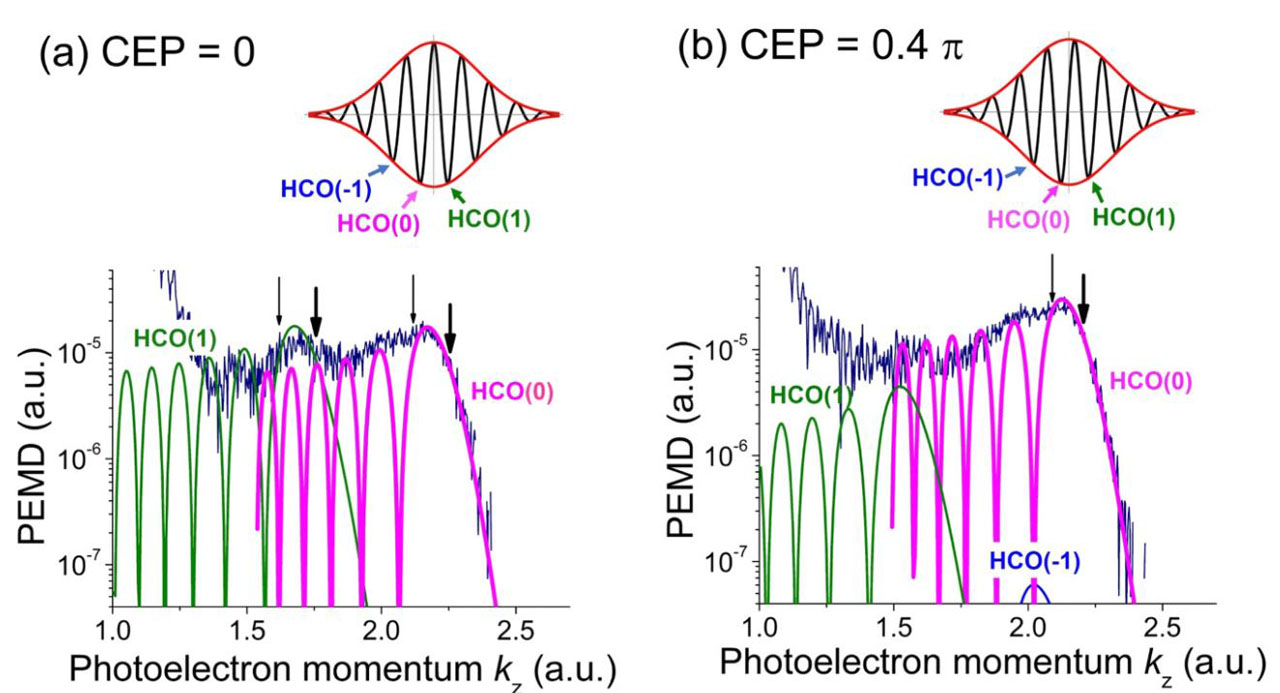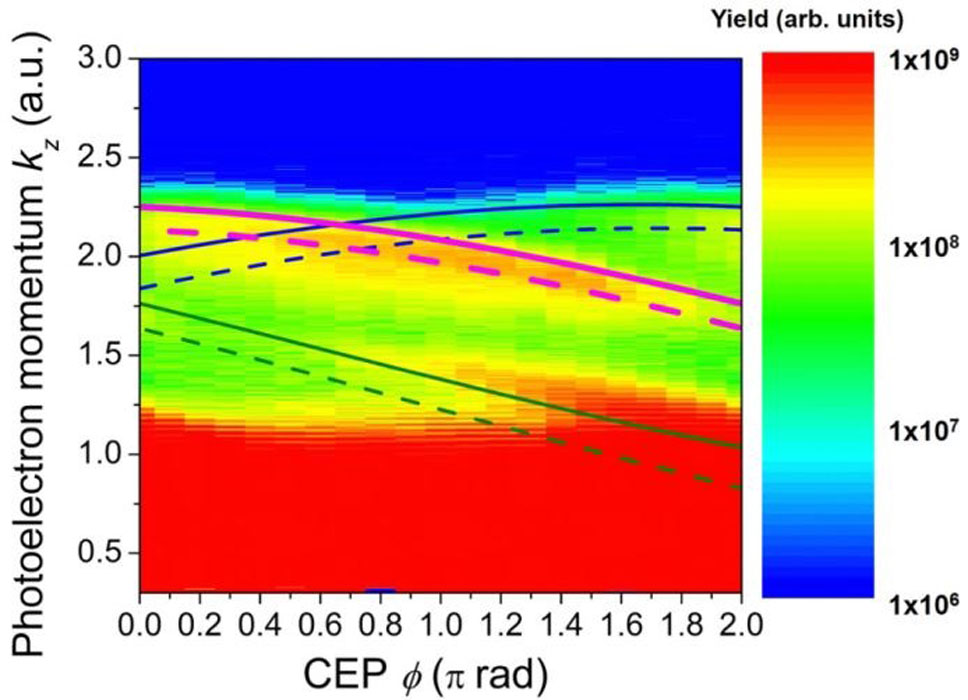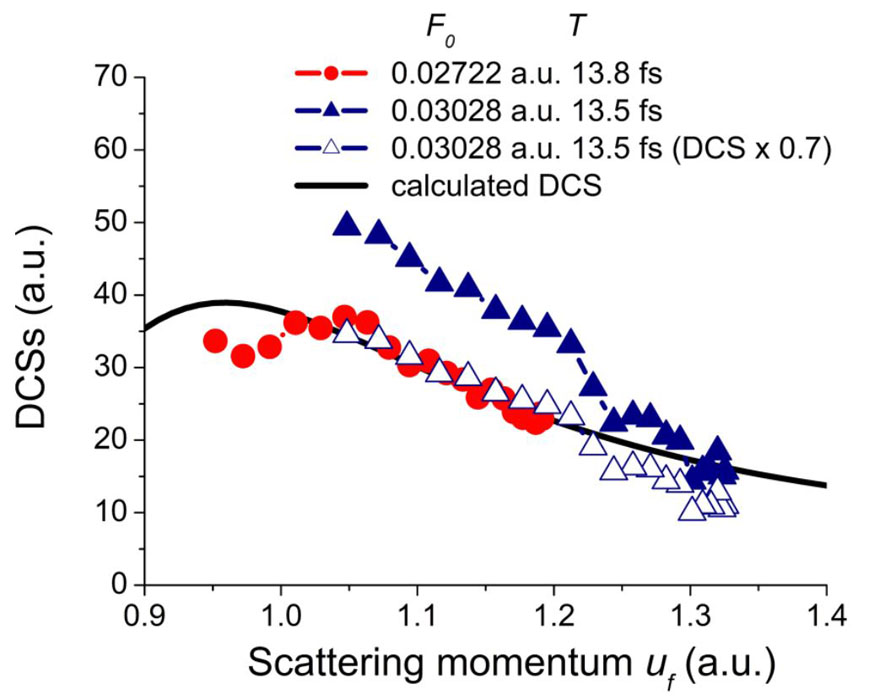Observation of the Quantum Shift of a Backward Rescattering Caustic by Carrier-Envelope Phase Mapping
Itatani Group
When an atom or molecule is exposed to linearly-polarized intense optical fields, an electron wavepacket is freed from the atom, accelerated by the field, then collides with the parent ion. This process, recollision, is the fundamental of attosecond science. When recollision becomes recombination, the ionizing atoms emits a high energy photon (high harmonic generation). Meanwhile, it is well known that a part of recolliding events becomes elastic scattering. Especially the backward rescattering leads to the generation of high-energy electrons with a drift kinetic energy up to 10Up, where Up is the ponderomotive potential. Recent theoretical progress of the adiabatic theory of rescattering gives an analytical formula for photoelectron momentum distributions (PEMDs) near the 10Up cutoff which is scaled by the cutoff energy. Although the theoretical treatment of rescattering is fully quantum mechanical and straightforward, the experimental verification has been very difficult because it is not easy to realize systematic experiments to extract well-defined single rescattering events with multi-cycle laser pulses.
We hereby used intense few-cycle pulses in infrared to measure the backward PEMDs with controlled carrier-envelope phases (CEPs). The extremely short duration of the optical pulse allows to extract the single rescattering events of the three highest energies, and the CEP control enables to systematically change the maximum intensity in the focused volume without affecting the other parameters such as spatial distribution of the field intensity. Figure 1 shows the CEP dependent PEMDs with a pulse energy of 210 μJ. Dashed and solid curves represent classical and quantum caustics. The CEP dependent PEMD assures the one-to-one correspondence of the electron momentum at the instance of rescattering and the CEP, which we call the CEP mapping method. From this CEP mapping, we successfully determined the field intensity and the pulse duration to be 2.6 × 1013 W/cm2 and 13.8 fs, respectively. Using these parameters, the observed PEMDs are deconvolved to three PEMDs that correspond to the rescattering events of different intensities within a single optical pulse, as shown in Fig. 2.

Fig. 2. Measured PEMDs at CEP=0 and 0.4π at an estimated intensity of 2.6 × 1013 W/cm2 and a pulse duration of 13.8 fs. The thick red, thin blue, and thin green curves show calculated PEMDs corresponding to a half cycle of the electric field as depicted in the top figures. Thin and thick arrows indicate the classical and quantum caustics, respectively.
The laser parameters, elastic scattering differential cross sections, and tunnel ionization rate of the taget are encoded in PDMDs. Such information can be extracted from the observed PEMDs based on the adiabatic theory. Based on the quantitative agreement of the observed cutoff behavior of PEMDs with the adiabatic theory, elastic scattering cross section as a function of scattering momenta is successfully determined as shown in Fig. 3.
In summary, we experimentally and theoretically explored the rescattering PEMDs of a Xe atoms near the cutoff using CEP-stable few-cycle pulses [1]. The observed PEMDs are well reproduced by the analytical formula of the adiabatic theory including the quantum shift of the caustics. The results not only demonstrate the fact that the CEP mapping method with the adiabatic rescattering theory allows to extract well-defined elastic scattering, but also opens an opportunity to use rescattering to observe novel electron states such as vortex electrons [2].
References
- [1] T. Mizuno, N. Ishii, T. Kanai, P. Rosenberger, D. Zietlow, M. F. Kling, O. Tolstikhin, T. Morishita, and J. Itatani, Phs. Rev. A 103, 043121 (2021).
- [2] O. I. Tolstikhin and T. Morishita, Phys. Rev. A 99, 063415 (2019).


